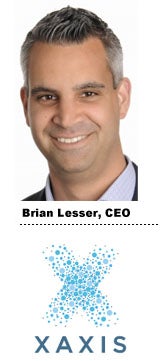 Although the major internet ad players – e.g., Pandora, Spotify, Last.fm – all swear by their direct sales, Xaxis, WPP’s audience buying unit, is looking to leverage audio ads as a way to get more brand campaign ad dollars within its programmatic system.
Although the major internet ad players – e.g., Pandora, Spotify, Last.fm – all swear by their direct sales, Xaxis, WPP’s audience buying unit, is looking to leverage audio ads as a way to get more brand campaign ad dollars within its programmatic system.
“The appeal [of internet radio audio ads] is that we want to give brand advertisers another vehicle for audience targeting,” said Xaxis CEO Brian Lesser in an interview with AdExchanger. “We fundamentally believe that programmatic buying lends itself very well to brand advertising, despite the fact that it’s mostly used, right now, for bottom of the funnel, direct response advertising. Our job within Xaxis is to make as many channels available to brand advertisers as possible through programmatic buying.”
It’s hard to find comprehensive figures for how much internet radio is bringing in these days, but suffice to say, consumer usage is surely outpacing ad spending. Last fall, digital audio ad network TargetSpot released a report attempting to put a face on internet radio listeners and suggested that they may be more amenable to being targeted in this format versus other mediums.
The TargetSpot study, though limited in scope to 1,000 respondents to an online survey last year, clearly gives Xaxis some hope in prying away direct sales dollars for targeted, branded campaigns:
- 65% of digital audio listeners are comfortable receiving ads based on their personal profiles and 70% are comfortable receiving ads based on their internet radio usage and/or content preference.
- 58% of internet radio listeners recall having seen or heard an online audio ad in the last 30 days, up 12% from last year.
- Of those who recalled an Internet Radio ad, 44% responded to it in some way, up 10% from last year.
So far, advertisers haven’t responded greatly to it.
Primarily, buyers of terrestrial radio ads aren’t able to access any seamless reporting of audience measurement numbers across various mobile and PC-based channels, including the streaming versions of over-the-air radio. Without clearer measurements, dollars are unlikely to move significantly any time soon.
That’s not to say that digital radio ads don’t have certain advantages at the moment. According to local ad spending researcher Borrell Associates, radio, along with print, is continuing to decline. It projects 2013 ad spending on radio will drop 5.9 percent. Those dollars are migrating to the web, and internet radio could make a play for those budgets.
The launch of Xaxis Radio as a completely programmatic buying product for targeting global audiences in the digital radio market is not intended as a mere experiment for marketers to test until the audio ad marketplace starts to show surer signs of maturity. After releasing Xaxis Radio in beta last month, Lesser said that two national advertisers – he wouldn’t identify them – have already committed budgets as part of ongoing campaigns.
The offering is integrated into the Xaxis Data Management Platform. The WPP unit is promising advertisers the ability to precisely measure attribution for their online radio ads as they would any other targeted ad.
“This is the great thing about the product is that everything is connected through our DMP via cookies, so we’re talking about 30-second audio ads, with a companion unit,” Lesser said. “In a larger sense, anything that we do in video or display in terms of third-party data, or using our own second-party data, we can now do with audio. It’s all about having a larger range of formats for brand advertisers to choose from. It breaks down the walls between online siloes and reduces the limitations to extending campaigns as far as they can go.”
There are no plans to include offline radio into the mix, though Xaxis has been placing ads in the streams of CBS Radio (sibling of Last.fm), NPR Digital, Pandora and Slacker.
To develop Xaxis Radio, the company partnered with Triton Digital, the digital services provider to traditional and online radio. Earlier this month, Triton took its own big step toward programmatic by unveiling a2x, programmatic buying technology for online audio inventory, which was created in partnership with data marketing specialist eXelate.
Xaxis Radio is starting off in the U.S. and will be made available to the WPP property’s 1,000-plus advertiser clients globally later this year.
As for whether this will create tensions within the larger WPP family – who makes the buy? The broadcast side or the digital side? – Lesser dismisses the notion.
“It will be bought the way we buy display or video, so it will be bought through a DSP, which will connect it to a marketplace, which is managed by Triton,” Lesser said. “It’s very seamless for us, because when we run a campaign, we are agnostic as to channels or device. We’re just looking for the specific user. The very simplest way you can think about this is, if we’re running a campaign based on visitors to one of our client’s websites, we can now buy those users in real time, via the marketplace’s pricing has created and serve them a 30 second audio ad.”











